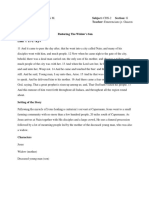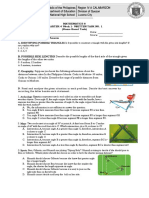Music of Indonesia. Location: Gamelan Is The Most Popular Form of Traditional Music
Music of Indonesia. Location: Gamelan Is The Most Popular Form of Traditional Music
Uploaded by
Natalya SongcalCopyright:
Available Formats
Music of Indonesia. Location: Gamelan Is The Most Popular Form of Traditional Music
Music of Indonesia. Location: Gamelan Is The Most Popular Form of Traditional Music
Uploaded by
Natalya SongcalOriginal Title
Copyright
Available Formats
Share this document
Did you find this document useful?
Is this content inappropriate?
Copyright:
Available Formats
Music of Indonesia. Location: Gamelan Is The Most Popular Form of Traditional Music
Music of Indonesia. Location: Gamelan Is The Most Popular Form of Traditional Music
Uploaded by
Natalya SongcalCopyright:
Available Formats
Music of Indonesia.
Location
Indonesia is an archipelago (or a group of islands) located off the coast of
Mainland Southeast Asia between the Indian and Pacific ocean.
Indonesia is thought to be derived from the Greek indos, meaning “India,”
and nesos, meaning “island.
Brief History:
Indonesia is the largest nation in Southeast Asia (by size) and the fourth
most populous country on earth. It is said to be a geological wonderland.
It is located in the equater and it is also the meeting point of the Indian and Pacific Oceans,
and well, you end up with one very interesting and exotic destination
KECAK DANCE
Kecak Dance is a traditional art of drama and dance from Bali. This dance is inspired by Sanghyang
rituals and parts of the Ramayana story.
Sanghyang ritual itself is a dance tradition where the dancers are in an unconscious condition and
communicate with God or the spirits of the ancestors then convey his hopes to the community.
The Kecak dance is unique in that it has no other musical background or accompaniment besides the
chanting of the troupe of bare-chested male dancers making a “chak-achak-achak” clicking sounds while
swaying their bodies and waving their hands. From that chanting noise of “Cak-cak-cak”, the dance was
given its name, Kecak.
Gamelan
Across Indonesia, but particularly on the islands of Java and Bali,
gamelan is the most popular form of traditional music.
A gamelan ensemble consists of a variety of metal percussion instruments,
usually made of bronze or brass, including xylophones, drums, and gongs.
It may also feature bamboo flutes, wooden stringed instruments, and vocalists, but the main
focus is on the percussion.
MELODY AND HARMONY
For any traditional gamelan piece, there is usually a basic version of the melody, which is very closely bound to the
form of the piece. There are also many variations on the melody, including versions that include a halt in the rhythm,
to give a feeling of cadence, as well as a variety of more or less embellished versions, which often have two, four, or
even eight times as many notes as basic versions of the melody. The signature texture that makes gamelan music so
unusual and easily recognizable is created by having different instruments play different versions of the melody at the
same time.
FORM
If everything that happens in a piece of music is new, the result sounds too random or it may sound boring;
composers use repetition to really make the listeners remember the tune in a piece of music.It is a very important
aspect of all kinds of music. As a piece develops, a previous section may return, as a whole or only in part, with or
without substantial changes, and possibly with new, unrelated material introduced between repeated sections, or
even interrupting sections.
In contrast to this linear conception, the basic organizing principle of traditional gamelan musical forms is cyclical.
Cyclical forms are based on a constant repetition, without interruptions, of a basic musical idea. In traditional
gamelan music, the repetition is so constant that the last note of each cycle is also the first note of the next cycle.
There are two main types of gamelan. The two styles differ but are based on the same principles.
Two main types of GAmelan
There are two main types of gamelan. The two styles differ but are based on the same principles.
Javanese Gamelan
It comes from the central and eastern parts of the island of Java
Balinese Gamelan
Scales
There are two different scale systems used in Balinese gamelan: slendro and pelog. It is
important to note that these are not scales with specific pitches, or even categories of scales
(such as major or minor) that have specific interval relationships.
The slendro system uses five notes within each octave that are of roughly equal distance from
each other. A very rough approximation of a slendro scale might be the Western notes A C D E
and G (a pentatonic scale fairly familiar to Westerners), with the C, D and G tuned noticeably
lower than equal temperament, so that the major second intervals and minor third intervals are
more (but probably not exactly) equal.
The pelog system uses seven notes within an octave, with unequal intervals between them. The
tuning tends to be close to that of the Western phrygian mode (E to E on the white keys of a
piano). Some types of gamelan have all seven pelog notes available, but these usually do not use
all seven pitches in one composition. Most commonly, groups of pitches are used as modes (for
example, only pitches 1, 2, 3, 5 and 6, or only 1, 2, 4, 5 and 6 of that approximate-phrygian
scale). Some gamelan only have one pelog mode available.
Pelog is a seven-note scale found in Indonesian music. Unlike Western scales, both the intervals
and the specific pitches vary widely. This example is just one possible construction of a pelog
scale. There is no association with the 12 notes available in Western music; these pitches are
"between the cracks."
You might also like
- Please Answer Briefly The Following Questions: 1. What Attributes Should The Conductor Show in The Patterns and Gestures?No ratings yetPlease Answer Briefly The Following Questions: 1. What Attributes Should The Conductor Show in The Patterns and Gestures?2 pages
- Planet Rothschild - The Forbidden History of The New World Order (WW2 - 2015)100% (1)Planet Rothschild - The Forbidden History of The New World Order (WW2 - 2015)347 pages
- Music of Indonesia: DCC Registered Qms-Dcc-Form16No ratings yetMusic of Indonesia: DCC Registered Qms-Dcc-Form1625 pages
- Gamelan: A Study of Javanese and Balinese Traditional MusicNo ratings yetGamelan: A Study of Javanese and Balinese Traditional Music5 pages
- Music in Indonesia: Philippine and Asian Music 1No ratings yetMusic in Indonesia: Philippine and Asian Music 141 pages
- Indonesianmusic 3 Topaz 130210110925 Phpapp01No ratings yetIndonesianmusic 3 Topaz 130210110925 Phpapp0125 pages
- Notes On The Balinese Gamelan Musik: by I G.B.N. PandjiNo ratings yetNotes On The Balinese Gamelan Musik: by I G.B.N. Pandji5 pages
- General Characteristics: Society and MusicNo ratings yetGeneral Characteristics: Society and Music4 pages
- Indonesia Is An Archipelago in Southeast Asia Comprising Approximately 17No ratings yetIndonesia Is An Archipelago in Southeast Asia Comprising Approximately 175 pages
- The Hero Is Overpowered But Overly CautiousNo ratings yetThe Hero Is Overpowered But Overly Cautious101 pages
- Chrisa Kitsiou, Music Theory - Solfège, Developing Aural Skills - Book 1From EverandChrisa Kitsiou, Music Theory - Solfège, Developing Aural Skills - Book 1No ratings yet
- Songcal - What Is Music Therapy - AssignmentNo ratings yetSongcal - What Is Music Therapy - Assignment1 page
- NT Books Author Date Purpose of Writing Community: Natalya Eleni M. Songcal Chs2No ratings yetNT Books Author Date Purpose of Writing Community: Natalya Eleni M. Songcal Chs22 pages
- MDS (Periodontology) : Applied Anatomy, Physiology, Biochemistry, Pathology and PharmacologyNo ratings yetMDS (Periodontology) : Applied Anatomy, Physiology, Biochemistry, Pathology and Pharmacology4 pages
- Cadmium Sulfide Enhances Solar Cell EfficiencyNo ratings yetCadmium Sulfide Enhances Solar Cell Efficiency5 pages
- List of Newly and Migrated Programs For September 2023 - WebsiteNo ratings yetList of Newly and Migrated Programs For September 2023 - Website39 pages
- RAMS For WaterProofing Membrane InstallationNo ratings yetRAMS For WaterProofing Membrane Installation30 pages
- GoldenParameter ZTE V4 With Dual Band Setting RV Rev1No ratings yetGoldenParameter ZTE V4 With Dual Band Setting RV Rev1181 pages
- Clarifying Capacity of Eco-Friendly Nano Cao and Okra (AbelmoschusEsculentus)No ratings yetClarifying Capacity of Eco-Friendly Nano Cao and Okra (AbelmoschusEsculentus)10 pages
- Thí sinh viết câu trả lời phần trắc nghiệm vào khung sau đây100% (2)Thí sinh viết câu trả lời phần trắc nghiệm vào khung sau đây4 pages
- Interview Prep: How To Guide: Laura Ballantyne - August 2020No ratings yetInterview Prep: How To Guide: Laura Ballantyne - August 202011 pages



































































































